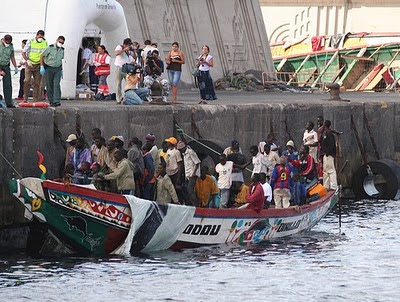The boat of salvation

Benedict Ahn is an enthusiastic entrepreneur with one goal in mind. Although the days of the Korean War was not yet born, wants to build a monument to friendship between the U.S. and Korea and a supply ship, the Meredith Victory, on the grounds of a monastery in New Jersey. Why is that boat at that site and at the present time? Because behind him is a story - and perhaps a miracle or two - which lasted 50 years.
A cold December night in 1950, six months after the outbreak of war, Leonard LaRue, captain of the Meredith Victory, took his boat, in battle and 300 tons of turbo in the cellars, the port of Hungnam, 217 miles north of latitude 38. Thousands of Chinese soldiers had entered North Korea to help the Communists and, to escape them, more than 90,000 peasants fled south along mountain paths to Hungnam, which was on fire by bombing.
In desperation, the refugees they got to the sea to try to get on any boat that might take them away. Leonard LaRue decided to help. Hid thousands in the cellars, where the terrified peasants were crammed shoulder to shoulder on hard platforms. The vessel sailed under the Chinese shooting two days before Christmas, with 14,000 people aboard. Despite the lack of food, water and heating in the hold, not one life was lost during the three day voyage to the island of Kojedo. Moreover, to December 25, five babies were born aboard.
In desperation, the refugees they got to the sea to try to get on any boat that might take them away. Leonard LaRue decided to help. Hid thousands in the cellars, where the terrified peasants were crammed shoulder to shoulder on hard platforms. The vessel sailed under the Chinese shooting two days before Christmas, with 14,000 people aboard. Despite the lack of food, water and heating in the hold, not one life was lost during the three day voyage to the island of Kojedo. Moreover, to December 25, five babies were born aboard.
LaRue was acclaimed in the world. But then confirmed in their faith by the extraordinary adventure, he entered the abbey of St. Paul, Benedictine Monastery of New Jersey, and became Brother Marinus.
When he arrived, all was activity: 50 monks managed a boarding school, a retreat center, a camp and a Christmas tree nursery. Moreover, as LaRue expected, the abbey was given peace.
However, in the 60 major cultural changes occurred within and outside the Church. After 47 years of faithful service to the abbey and its library, Marinus was dying, like his beloved monastery. It was 2001, and in 25 years not a single monk had entered and remained in the abbey. It seemed that the spiritual life that the former captain had started with such happiness end in isolation and desolation.
When he arrived, all was activity: 50 monks managed a boarding school, a retreat center, a camp and a Christmas tree nursery. Moreover, as LaRue expected, the abbey was given peace.
However, in the 60 major cultural changes occurred within and outside the Church. After 47 years of faithful service to the abbey and its library, Marinus was dying, like his beloved monastery. It was 2001, and in 25 years not a single monk had entered and remained in the abbey. It seemed that the spiritual life that the former captain had started with such happiness end in isolation and desolation.
The abbot greater Jeremias Schroeder, leader of the congregation in Germany, began looking for solutions not to close the monastery. Marinus I knew the story, and knew also that many Korean Catholics had emigrated to New Jersey.
He got in touch with the flourishing monastery monks Waegwan South Korea, founded in 1952, the year he was banned the Meredith Victory and Captain Leonard LaRue began a new life. It turned out that these monks were looking for a relief and, on 12 October 2001, Father Bosco Kim accepted the challenge of rescuing the abbey of St. Paul. Two days later, Marinus died peacefully at the age of 87.
Since then, the abbey has been rejuvenated. Every Sunday there are masses in English and Korean. The new gardens produce an abundant harvest of vegetables, the retreat center has returned to service, and Korean throughout the metropolitan area of New York come to pray and do volunteer work. The Rev. Bosco Kim said: "We believe it is time to give something back"
He got in touch with the flourishing monastery monks Waegwan South Korea, founded in 1952, the year he was banned the Meredith Victory and Captain Leonard LaRue began a new life. It turned out that these monks were looking for a relief and, on 12 October 2001, Father Bosco Kim accepted the challenge of rescuing the abbey of St. Paul. Two days later, Marinus died peacefully at the age of 87.
Since then, the abbey has been rejuvenated. Every Sunday there are masses in English and Korean. The new gardens produce an abundant harvest of vegetables, the retreat center has returned to service, and Korean throughout the metropolitan area of New York come to pray and do volunteer work. The Rev. Bosco Kim said: "We believe it is time to give something back"
Benedict Ahn want to return something else. He speaks enthusiastically about his campaign to build the monument. He has a website and a colorful brochure showing a model: a green meadow in the middle is a black monolith with a boat shaped base and a roof Korean and auction.
It is a chest that symbolizes the daring rescue of 14,000 souls and a tribute to what he can achieve the life of a man of faith.
Author:Jennifer Goldblatt
It is a chest that symbolizes the daring rescue of 14,000 souls and a tribute to what he can achieve the life of a man of faith.
Author:Jennifer Goldblatt


Comments
Post a Comment